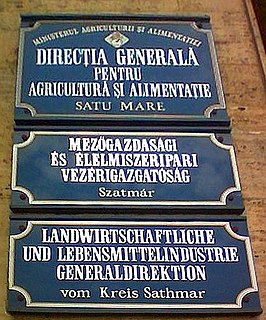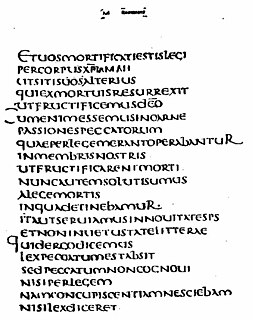In linguistics, an allomorph is a variant phonetic form of a morpheme, or, a unit of meaning that varies in sound and spelling without changing the meaning. The term allomorph describes the realization of phonological variations for a specific morpheme. The different allomorphs that a morpheme can become are governed by morphophonemic rules. These phonological rules determine what phonetic form, or specific pronunciation, a morpheme will take based on the phonological or morphological context in which they appear.
A lexicon is the vocabulary of a language or branch of knowledge. In linguistics, a lexicon is a language's inventory of lexemes. The word lexicon derives from Greek word λεξικόν, neuter of λεξικός meaning 'of or for words'.
A lexeme is a unit of lexical meaning that underlies a set of words that are related through inflection. It is a basic abstract unit of meaning, a unit of morphological analysis in linguistics that roughly corresponds to a set of forms taken by a single root word. For example, in English, run, runs, ran and running are forms of the same lexeme, which can be represented as RUN.

A morpheme is the smallest meaningful lexical item in a language. A morpheme is not a word. The difference between a morpheme and a word is that a morpheme sometimes does not stand alone, but a word on this definition always stands alone. The field of linguistic study dedicated to morphemes is called morphology.
Morphophonology is the branch of linguistics that studies the interaction between morphological and phonological or phonetic processes. Its chief focus is the sound changes that take place in morphemes when they combine to form words.
In linguistics, morphology is the study of words, how they are formed, and their relationship to other words in the same language. It analyzes the structure of words and parts of words such as stems, root words, prefixes, and suffixes. Morphology also looks at parts of speech, intonation and stress, and the ways context can change a word's pronunciation and meaning. Morphology differs from morphological typology, which is the classification of languages based on their use of words, and lexicology, which is the study of words and how they make up a language's vocabulary.
In linguistics and etymology, suppletion is traditionally understood as the use of one word as the inflected form of another word when the two words are not cognate. For those learning a language, suppletive forms will be seen as "irregular" or even "highly irregular".

In linguistics, agglutination is a morphological process in which words are formed by stringing together morphemes which each correspond to a single syntactic feature. Languages that use agglutination widely are called agglutinative languages. Turkish is one example of an agglutinative language since, for example, the word evlerinizden consists of the morphemes ev-ler-iniz-den, literally translated morpheme-by-morpheme as house-plural-your(plural)-from. Agglutinative languages are often contrasted with isolating languages where words are monomorphemic and fusional languages in which words can be complex, but morphemes may correspond to multiple features.
A root is the core of a word that is irreducible into more meaningful elements. In morphology, a root is a morphologically simple unit which can be left bare or to which a prefix or a suffix can attach. The root word is the primary lexical unit of a word, and of a word family, which carries aspects of semantic content and cannot be reduced into smaller constituents. Content words in nearly all languages contain, and may consist only of, root morphemes. However, sometimes the term "root" is also used to describe the word without its inflectional endings, but with its lexical endings in place. For example, chatters has the inflectional root or lemma chatter, but the lexical root chat. Inflectional roots are often called stems, and a root in the stricter sense, a root morpheme, may be thought of as a monomorphemic stem.
In generative linguistics, Distributed Morphology is a theoretical framework introduced in 1993 by Morris Halle and Alec Marantz. The central claim of Distributed Morphology is that there is no divide between the construction of words and sentences. The syntax is the single generative engine that forms sound-meaning correspondences, both complex phrases and complex words. This approach challenges the traditional notion of the Lexicon as the unit where derived words are formed and idiosyncratic word-meaning correspondences are stored. In Distributed Morphology there is no unified Lexicon as in earlier generative treatments of word-formation. Rather, the functions that other theories ascribe to the Lexicon are distributed among other components of the grammar.
In linguistics, a stem is a part of a word responsible for its lexical meaning. The term is used with slightly different meanings depending on the morphology of the language in question. In Athabaskan linguistics, for example, a verb stem is a root that cannot appear on its own, and that carries the tone of the word. Athabaskan verbs typically have two stems in this analysis, each preceded by prefixes.

In linguistics, a word of a spoken language can be defined as the smallest sequence of phonemes that can be uttered in isolation with objective or practical meaning. In many languages, words also correspond to sequences of graphemes ("letters") in their standard writing systems that are delimited by spaces wider than the normal inter-letter space, or by other graphical conventions. The concept of "word" is usually distinguished from that of a morpheme, which is the smallest unit of word which has a meaning, even if it will not stand on its own together or in other small words.
In linguistics, apophony is any sound change within a word that indicates grammatical information.

Nonconcatenative morphology, also called discontinuous morphology and introflection, is a form of word formation and inflection in which the root is modified and which does not involve stringing morphemes together sequentially.
In linguistics, a suprafix is a type of affix that gives a suprasegmental pattern to either a neutral base or a base with a preexisting suprasegmental pattern. This affix will, then, convey a derivational or inflectional meaning. This suprasegmental pattern acts like segmental phonemes within a morpheme; the suprafix is a combination of suprasegmental phonemes, organized into a pattern, that creates a morpheme. For example, a number of African languages express tense / aspect distinctions by tone. English has a process of changing stress on verbs to create nouns.
In linguistics, syncretism exists when functionally distinct occurrences of a single lexeme, morph or phone are identical in form. The term arose in historical linguistics, referring to the convergence of morphological forms within inflectional paradigms. In such cases, a former distinction has been 'syncretized'. The term syncretism is often used when a fairly regular pattern can be observed across a paradigm.
Nanosyntax is an approach to syntax where the terminal nodes of syntactic parse trees may be reduced to units smaller than a morpheme. Each unit may stand as an irreducible element and not be required to form a further "subtree." Due to its reduction to the smallest terminal possible, the terminals are smaller than morphemes. Therefore, morphemes and words cannot be itemised as a single terminal, and instead are composed by several terminals. As a result, Nanosyntax can serve as a solution to phenomena that are inadequately explained by other theories of syntax.
In linguistics, morphological leveling or paradigm leveling is the generalization of an inflection across a linguistic paradigm, a group of forms with the same stem in which each form corresponds in usage to different syntactic environments, or between words. The result of such leveling is a paradigm that is less varied, having fewer forms.
Odia grammar is the study of the morphological and syntactic structures, word order, case inflections, verb conjugation and other grammatical structures of Odia, an Indo-Aryan language spoken in South Asia.

In linguistic morphology, inflection is a process of word formation, in which a word is modified to express different grammatical categories such as tense, case, voice, aspect, person, number, gender, mood, animacy, and definiteness. The inflection of verbs is called conjugation, and one can refer to the inflection of nouns, adjectives, adverbs, pronouns, determiners, participles, prepositions and postpositions, numerals, articles etc., as declension.




